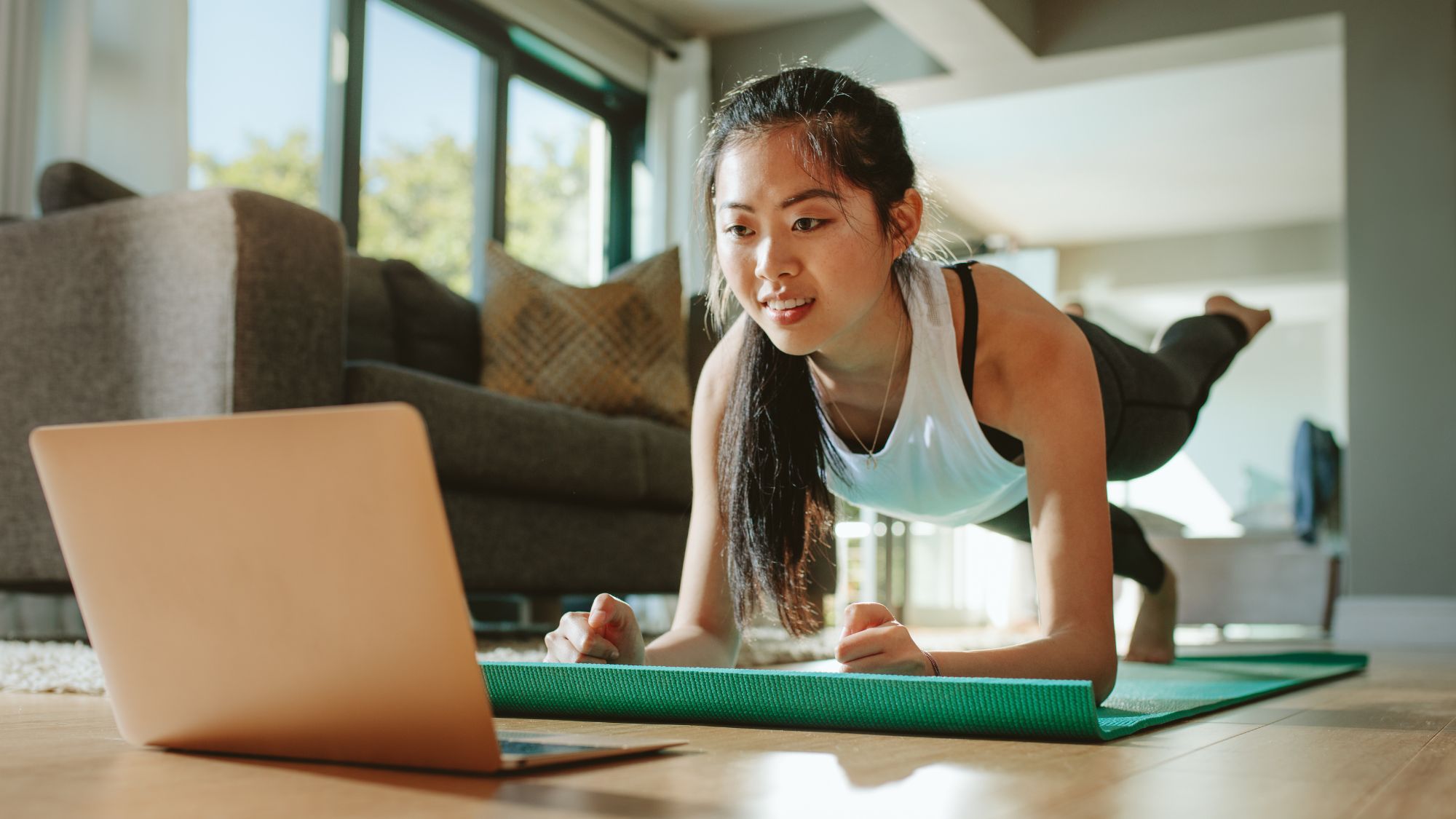Calisthenics workouts are at breakout on Google - here's how they improve both muscle and flexibility from home
Who knew bodyweight could be so effective?


Right now, everyone wants to know about callisthenics workouts. Honestly, we're not surprised: callisthenics combines some of the best bodyweight exercises and is arguably one of the most effective forms of strength training you can do (not to mention, it''ll give you some brilliant party tricks, too).
It's having a bit of a moment at current, and for good reason. PureGym listed calisthenics as one of the hottest workouts for 2023 while over on TikTok, #calisthenics has over 20 billion views. In the UK, google searches for the workout have been slowly growing ever since lockdown, with fans including Jennifer Aniston, Halle Berry and Gigi Hadid all reported to be fans of the type of training.
That's because calisthenics helps you build strength without using a single piece of equipment, which was why interest surged during the pandemic. The reason it's not slowed since we've had access to gyms? Because it's so effective.
One study published in the Isokinetics and Exercise Science journal found that eight weeks of calisthenics training improved posture, strength and body composition without the use of any major training equipment - in that time, press up strength improved by over 16% while participants pull ups also improved by a huge 39%.
"There is nothing more satisfying than mastering your bodyweight and performing a certain skill you have dreamed of doing," agrees calisthenics coach Alistair Sanders from East Coast Calisthenics.
For your complete guide to the at-home workout - which yep, can be done from anywhere - keep scrolling. Check out our guides to the best at-home bodyweight workout, full body workout, and bodyweight leg workout, if you're looking for other kit-free sessions.
Calisthenics workouts are trending: how the at-home workout boosts strength
What is calisthenics?
What separates calisthenics from general body weight training, then? "Calisthenics derives from the Greek words kalos, meaning beauty, and sthenos, meaning strength," explains Sanders. In that sense, it's a style of training that focuses on using your body, not just working it.
Celebrity news, beauty, fashion advice, and fascinating features, delivered straight to your inbox!
"Calisthenics takes many elements from sports such as gymnastics and yoga to turn your body into its own multi-gym," Sanders adds.
Many of the key exercises in calisthenics are handstands, press ups and pull-ups, a fusion of traditional strength and more artistic gymnastics. "Calisthenics offers all the benefits of conventional training but with that added bonus of learning skills that make you look superhuman," continues Sanders.
Sounds good, right?
What are the benefits of calisthenics training?
Apart from it being free to try and only requiring your own bodyweight, there are plenty of well-documented benefits.
1. It builds strength and fitness
Bodyweight training doesn't get the same respect as lifting weights for building strength, but the studies suggest that shouldn't be the case.
A 2018 paper looked at calisthenic-style push-up training versus traditional weighted bench press and found they both effectively improved the maximum strength of participants. Of course, throw in the added bonus of calisthenics requiring no kit and no gym membership, and you're on to free strength gains right there.
2. It boosts your skill-based training
Calisthenics is a skill-based sport, so you don't only get stronger and fitter but also learn some new tricks. That has more benefits than showing off at a party - it's also brilliant for your mind and body.
"There is nothing more satisfying than mastering your bodyweight and performing a certain skill you have dreamed of doing," says Sanders. "You get stronger the skill increases and there's no upper limit for how you use your strength: a push-up could turn into a handstand, a handstand into a handstand push-up, and so on."
Does a push-up sound a bit, well, daunting? Don't worry - calisthenics is suitable for all fitness levels and abilities and aims to help you work up to more advanced moves, like a push-up or pull-up. You'll also never start with the hardest moves, says Sanders. "Most people associate calisthenics with advanced moves such as muscle ups and handstands, but it doesn't start there. It's accessible to every no matter your fitness, age or ability," he says.
3. It's exciting
Not everyone gets on with the traditional set-rest workout structure - and that's ok.
That's where calisthenics comes in, offering a different form of training that might be more exciting for you. While finding out what workout you genuinely enjoy and that you'll look forward to every day is key, it's a great option for the time-poor or those of you who get bored easily, as it taps into many of the forms of movement from your childhood like forward rolls, handstands and balancing.
4 best calisthenics exercises to practice:
Keen to give it a go tonight? Don't let the terms handstand or elbow lever put you off. Calisthenics might sound scary but it's also safe: a German Sports Journal study reported that calisthenics has a lower injury rate than sports with similar demands such as powerlifting and gymnastics.
The best way to begin is to start with finding a coach who can guide you through your workouts, but if you want a taster of calisthenics, try adding the below exercises into your workout.
1. Wall handstand holds
A post shared by Shona Vertue (@shona_vertue)
A photo posted by on
What? Using a wall is the classic way to learn how to handstand but kicking up to it isn't the best way to learn your form. Instead, walk up it with your face facing the wall, getting as close as you feel confident.
Why? You won't be diving straight into a handstand but it does help to get upside down and perfect your shape before moving onto unsupported handstands.
How long for? Hold for up to 30 seconds at a time.
2. Push ups

What? Push-ups are such a classic bodyweight move. Starting from plank, you'll lower your chest to the floor and press all the way back up, but beginners can go from their knees or use a wall.
Why? Push-ups build full body strength - the pecs, shoulders, core and even legs will be working. That muscle will then help you nail other calisthenic skills.
How long for? To build strength you need to work to failure, so do as many reps as you can.
3. Scapula hangs
What? Hanging from the bar doesn't look like much, but in this move you'll be contracting your shoulder blades to build strength and technique in the upper body.
Why? You do need a bar for this, so it's not totally equipment free, but it's a great way to build upper body strength for those who haven't quite nailed a pull up yet.
How long for? This is another great exercise to do for 30 seconds.
4. Seated single leg lifts
A post shared by Jasmin | Calisthenics & Veggie Food 🤸🏽♂️🌱 (@fitandfreschy)
A photo posted by on
What? An L-sit is where you lift your legs up from seated in front of you and is the processor to V-sits and mannas, which is like a reverse handstand. Before you do any of that, start by conditioning those muscles with a single leg lift.
Why? It builds core and hip flexor strength as well as improves control and coordination.
How long for? Try to do single leg lifts for at least 30 seconds on each side.
"I tried calisthenics and have never felt stronger or more confident"
Lisa Brown took up calisthenics two years ago, and it's since become her favourite way to train.
"I started calisthenics after seeing people doing these amazing movements with their bodies online. I wanted to get involved," she tells Marie Claire UK. "I thought it looked like a much more fun way to build some strength than traditional gym training. While it's been a slow process, I've noticed a massive difference in how strong I feel since starting. I recently nailed an "elbow lever" - a move where you balance on your upper arms - and I'm still buzzing from it.
"I also notice a difference in my confidence, too. I think calisthenics has made me more aware of my body and what it can do which I have tried to apply it to my other training, as well."
"The classes are so welcoming that it feels like a big family and everyone cheers on everyone else’s success. It is easy to underplay your own progress, but when you have a group of supportive cheerleaders, it really helps you to feel better about your skills."
How do I start calisthenics?
According to calisthenics coach Alistair Sanders from East Coast Calisthenics, the best way is to head down to a calisthenics-specific workout class or chat with a trainer who's a specialist in the area.
That said, it's a bodyweight workout that requires no kit, so it's also easy to do from home if you'd prefer. Moves like push ups, handstand holds against a wall, and leg lifts are all traditional calisthenics moves that promise to boost both your strength and tone.

Chloe Gray is a freelance journalist who writes and talks about health, fitness, and wellbeing through a feminist lens. She was part of the launch team for Stylist magazine's fitness brand, Strong Women, and has written for i news, Women's Health, Red magazine, Good Housekeeping, Refinery29, and more. She's all about building mental and physical strength, eating delicious food that fuels you well, and making the fitness industry more accessible and enjoyable. She's also a qualified fitness trainer and research nerd, so you can be sure everything you read is backed by proper science.
